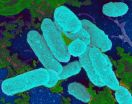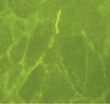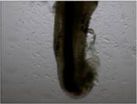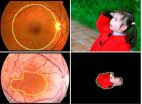(Press-News.org) Researchers from the University of Southern California and the Oak Crest Institute of Science have discovered the link between antibiotics and bacterial biofilm formation leading to chronic lung, sinus and ear infections. The study results, published in the current issue of PLOS ONE, illustrate how bacterial biofilms can actually thrive, rather than decrease, when given low doses of antibiotics.
"This research addresses the long standing issues surrounding chronic ear infections and why some children experience repeated ear infections even after antibiotic treatment," said Paul Webster, PhD, lead author, senior staff scientist at USC and senior faculty at the Oak Crest Institute of Science. "Once the biofilm forms, it becomes stronger with each treatment of antibiotics."
During the study, non-typeable Haemophilus influenzae (NTHi) bacteria a common pathogen of humans was exposed to non-lethal doses of ampicillin, a class of antibiotics commonly used to treat respiratory, sinus and ear infections, or other beta-lactam antibiotics. The dose of the antibiotic was not enough to kill the bacteria which allowed the bacteria to react to the antibiotic by producing glycogen, a complex sugar often used by bacteria as a food source, to produce stronger biofilms when grown in the laboratory.
Biofilms are highly structured communities of microorganisms that attach to one another and to surfaces. The microorganisms group together and form a slimy, polysaccharide cover. This layer is highly protective for the organisms within it, and when new bacteria are produced they stay within the slimy layer. With the introduction of antibiotic-produced glycogen, the biofilms have an almost endless food source that can be used once antibiotic exposure has ended.
There are currently no approved treatments for biofilm-related infections. Therefore, bacteria forced into forming stronger biofilms will become more difficult to treat and will cause more severe chronic infections. Adults will suffer protracted lung infections as the bacteria hunker down into their protective slime, and children will have repeated ear infections. What may appear to be antibiotic resistance when an infection does not clear up may actually be biofilms at work.
Webster believes modern medicine needs to find ways of detecting and treating biofilm infections before the bacteria are able to form these protective structures. The difficulties of treating biofilm infections, which can be up to 1,000 times more resistant to antibiotics, have prompted some physicians to propose a gradual move away from traditional antibiotic treatments and toward non-antibiotic therapies.
"If antibiotics are to continue to be relevant for treating bacterial infections it is important that their effects on biofilms be explored," says Dr. Webster.
"One step in this direction would be to develop routine screening methods to test the effects of antibiotics on in vitro formed biofilms."
INFORMATION: END
Scientist finds link between antibiotics, bacterial biofilms and chronic infections
Results may lead to new approach for treatment of chronic ear infections in children
2014-07-10
ELSE PRESS RELEASES FROM THIS DATE:
BMSCs with Nogo-66 receptor gene silencing for repair of spinal cord injury
2014-07-10
After central nervous system injury, the increase in Nogo protein is mediated by Nogo-66 receptor gene, leading to the collapse of growth cones and inhibiting the extension of neuronal neurites. Zhiyuan Li and his team, Heibei Xingtai People's Hospital, China used RNA interference to silence Nogo-66 receptor gene expression in bone marrow mesenchymal stem cells (BMSCs), blocked the inhibitory effect of Nogo protein, promoted the process growth of neurons differentiated by transplanted cells, improved the therapeutic effects and increased the success rate of BMSCs transplantation ...
Inhibition of NgR expression reduces apoptotic retinal ganglion cells in diabetes
2014-07-10
Activation of Nogo receptor (NgR) is an essential factor of nerve regeneration inhibition, neuronal atrophy and even apoptosis. Upregulation of NgR expression is an important cause of cell apoptosis and visual extinction in some diseases including glaucoma. Whether ganglion cell apoptosis is related to NgR gene expression in diabetes mellitus remains poorly understood. Dr. Xuezheng Liu and his team, Liaoning Medical University, China interfered NgR expression in the retinal ganglion cells of rats with diabetes mellitus and found that Rho kinase expression was obviously ...
Fusion protein of single-chain variable domain fragments and myasthenia gravis
2014-07-10
Single-chain variable domain fragment (scFv) 637 is an antigen-specific scFv of myasthenia gravis and it can bind to acetylcholine receptor in the residues 67-76 of α-subunit of acetylcholine receptor. Dr. Fanping Meng and his team, College of Medicine, Yanbian University in China conjugated scFv and human serum albumin genes and detected the fusion protein in Pichia pastoris. Results showed that the fusion protein bound to acetylcholine receptors in neuromuscular junction of human intercostal muscle and the inhibition rate of fusion protein binding to acetycholine ...
How does miR-21 promote the differentiation of hair follicle-derived NCSCs into SCs?
2014-07-10
Hair follicle-derived neural crest stem cells (NCSCs) can be induced to differentiate into Schwann cells (SCs). However, the underlying regulatory mechanism during cell differentiation remains poorly understood. Dr. Yuxin Ni and her team, Hospital of Stomatology, Jilin University, China isolated NCSCs from human hair follicle and induced them to differentiate into SCs. MicroRNA (miR-21) expression was gradually increased during the differentiation of NCSCs into SCs. After transfection with the miR-21 agonist (agomir-21), the differentiation capacity of NCSCs was increased. ...
The optimal mitomycin C concentration for intact peripheral nerve structure and function
2014-07-10
Recently, local scar adhesion after laminectomy always challenges the worldwide scholars engaged in spine surgery. Mitomycin C, a classical anti-tumor drug, has been attempted to be used to effectively inhibit scar adhesion after laminectomy and some encouraging outcomes have been achieved. However, there is evidence that mitomycin C has inherent toxicity and other side effects when it is locally used. Whether mitomycin C can influence peripheral nerve structure and function remains unclear. Dr. Tao Sui and his team, the First Affiliated Hospital of Nanjing Medical University, ...
New research: Fresh avocado enhances absorption of essential nutrients for healthy living
2014-07-10
IRVINE, Calif. (July 10, 2014) – Consuming a whole fresh avocado with either an orange-colored tomato sauce or raw carrots significantly enhanced provitamin A carotenoid (alpha- and beta-carotene) absorption and conversion of these carotenoids to an active form of vitamin A, according to new research (1) published in The Journal of Nutrition.
Vitamin A is involved in reproductive health and growth promotion; helps support healthy skin, immune function, and vision; and has antioxidant properties. Provitamin A carotenoids, like alpha- and beta-carotene, impart the orange ...
Invasion of yellow crazy ant in a Seychelles UNESCO palm forest: Threats and solutions
2014-07-10
The yellow crazy ant Anoplolepis gracilipes is ranked amongst the top 100 worst global invasive species and is responsible for catastrophic ecological impacts on islands. A new study published in the open access journal NeoBiota examines and assesses the effects and dangers of the introduction of the yellow crazy ant to the unique,endemic ecosystem of the mature palm forest of the Vallée de Mai, a UNESCO World Heritage Site, on the Seychelles.
The palm forest of Vallée de Mai is a unique ecosystem containing many endemic species, including the iconic coco de mer palm ...
New diagnostic test to distinguish psoriasis from eczema
2014-07-10
In some patients, the chronic inflammatory skin diseases psoriasis* and eczema** are similar in appearance. Up to now, dermatologists have therefore had to base their decision on which treatment should be selected on their own experience and an examination of tissue samples. A team of researchers at the Helmholtz Zentrum München and the Technical University of Munich (TUM) have now analyzed the molecular processes that occur in both diseases and discovered crucial differences. This has enabled them for the first time to gain a detailed understanding of the ways in which ...
Mobile phone bling may be a personal, but also cultural thing
2014-07-10
Choosing mobile phone cases and customizing phones with charms and decorations may reveal a lot about a person's culture, as well as increase attachment to the devices, according to researchers.
In a study on culture and mobile phone customization, researchers found that people from Eastern cultures tend to be more motivated to change the look and sound of their mobile phones than people in Western countries, said S. Shyam Sundar, Distinguished Professor of Communications and co-director of the Media Effects Research Laboratory, Penn State.
"People who live in collectivist ...
Patient-specific stem cells and personalized gene therapy
2014-07-10
NEW YORK, NY (July 10, 2014) — Columbia University Medical Center (CUMC) researchers have created a way to develop personalized gene therapies for patients with retinitis pigmentosa (RP), a leading cause of vision loss. The approach, the first of its kind, takes advantage of induced pluripotent stem (iPS) cell technology to transform skin cells into retinal cells, which are then used as a patient-specific model for disease study and preclinical testing.
Using this approach, researchers led by Stephen H. Tsang, MD, PhD, showed that a form of RP caused by mutations to the ...
LAST 30 PRESS RELEASES:
Why nail-biting, procrastination and other self-sabotaging behaviors are rooted in survival instincts
Regional variations in mechanical properties of porcine leptomeninges
Artificial empathy in therapy and healthcare: advancements in interpersonal interaction technologies
Why some brains switch gears more efficiently than others
UVA’s Jundong Li wins ICDM’S 2025 Tao Li Award for data mining, machine learning
UVA’s low-power, high-performance computer power player Mircea Stan earns National Academy of Inventors fellowship
Not playing by the rules: USU researcher explores filamentous algae dynamics in rivers
Do our body clocks influence our risk of dementia?
Anthropologists offer new evidence of bipedalism in long-debated fossil discovery
Safer receipt paper from wood
Dosage-sensitive genes suggest no whole-genome duplications in ancestral angiosperm
First ancient human herpesvirus genomes document their deep history with humans
Why Some Bacteria Survive Antibiotics and How to Stop Them - New study reveals that bacteria can survive antibiotic treatment through two fundamentally different “shutdown modes”
UCLA study links scar healing to dangerous placenta condition
CHANGE-seq-BE finds off-target changes in the genome from base editors
The Journal of Nuclear Medicine Ahead-of-Print Tip Sheet: January 2, 2026
Delayed or absent first dose of measles, mumps, and rubella vaccination
Trends in US preterm birth rates by household income and race and ethnicity
Study identifies potential biomarker linked to progression and brain inflammation in multiple sclerosis
Many mothers in Norway do not show up for postnatal check-ups
Researchers want to find out why quick clay is so unstable
Superradiant spins show teamwork at the quantum scale
Cleveland Clinic Research links tumor bacteria to immunotherapy resistance in head and neck cancer
First Editorial of 2026: Resisting AI slop
Joint ground- and space-based observations reveal Saturn-mass rogue planet
Inheritable genetic variant offers protection against blood cancer risk and progression
Pigs settled Pacific islands alongside early human voyagers
A Coral reef’s daily pulse reshapes microbes in surrounding waters
EAST Tokamak experiments exceed plasma density limit, offering new approach to fusion ignition
Groundbreaking discovery reveals Africa’s oldest cremation pyre and complex ritual practices
[Press-News.org] Scientist finds link between antibiotics, bacterial biofilms and chronic infectionsResults may lead to new approach for treatment of chronic ear infections in children







